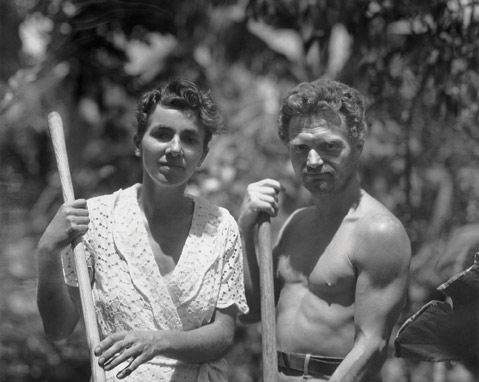Review: The Galapagos Affair: Satan Came to Eden
A documentary film written by Daniel Geller, Dayna Goldfine, and Celeste Schaefer Snyder and directed by Geller and Goldfine.

The whole point of the Adam and Eve tale is to highlight the infinite perversity of human beings and the extent to which they will screw things up, even if given perfection on a silver platter. The Galapagos Affair, a flawed, frustrating, yet fascinating documentary about a doomed effort by a German couple to create their own island paradise, reminds us that at least in this regard, the Bible got it right. Since four of the major players in this failed five-year utopian experiment wound up either dead or disappeared, the film purports to give us a whodunit, but one in which the goods never quite get delivered. Even so, this pseudo mystery works just fine as a sublime meditation on all the ways human beings can’t get along.
The story begins in 1929, when Friedrich Ritter, a German doctor obsessed with proto-existential philosopher Friedrich Nietzsche, decides to leave his wife and take up with a sick patient, Dore Strauch, on Florean Island off the coast of Ecuador. “Floreana,” as they dub it, is hot, dry, rocky, inhospitable, and unforgiving, much like the overbearing personality of the doctor himself, who had precious little good to say of his long-suffering partner. Together, the two are resourceful, courageous, and determined, living naked and hacking some semblance of an existence from the island’s unyielding and steep terrain. When Southern California oil man, yachtsman, and amateur anthropologist Allan Hancock — whose thumbprints remain all over the Santa Maria Valley — stumbled onto the Floreana experiment, the world press was soon agog with stories about the freaky Nietzschean nudists. Such accounts inspired Heinz Wittmer, another German of adventurous spirit, to pick up stakes with his wife and sickly teenage son and make like the Swiss Family Robinson, much to Ritter and Strauch’s chagrin. The story really picks up steam with the arrival Baroness Eloise Wehrborn de Wagner-Bosquet, who shows up with two lovers and an Ecuadorean manservant in tow. Her plan, naturally, was to re-create the island as tourist destination and build a grand hotel.
Of course, once Baroness arrives so, too, does the yacht traffic. Right around that time, Hancock started visiting Floreana with a film crew, the footage from which provides this documentary its real visual meat. There are also clips from Hancock’s dramatic home movie, featuring a pistol-packing Baroness sashaying around in racy clothing. Meanwhile, actors such as Cate Blanchett read from the journals of the various players, detailing their daily life and constant strife.
The Galapagos Affair has obvious resonance for Santa Barbara, as it highlights the typical progression of personalities that confound all idyllic refuges. It all starts with the ruggedly irascible pioneers, who “discover” someplace new, only to be unhappily swamped by settlers drawn to what they stumbled upon. Both groups are then overwhelmed by a tsunami of glitz and glam and real estate flimflam. In this tale, the Baroness and one of her lovers disappear mysteriously in 1934; no bodies were ever found. The remains of the second lover washed up later on another island. The mystery is never solved, but the filmmakers strongly imply it was the bourgeoisie Wittmers who took care of business.
It’s hard to imagine how anyone could get in the way of such a true-life parable, but filmmakers Dayna Goldfine and Daniel Geller ultimately get bogged down by their story. The narrative flow is at times distracting, jumbled, and unclear, the product of an abundance of riches that proved too hard to pare down. Still, this wonderfully weird and tragically inevitable tale is well worth the effort.



